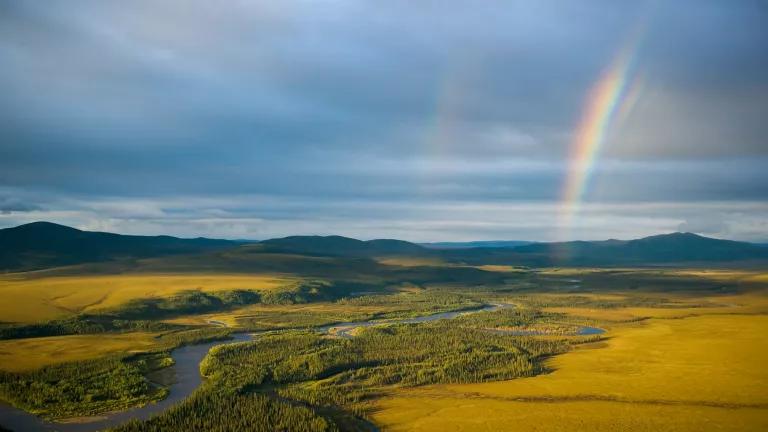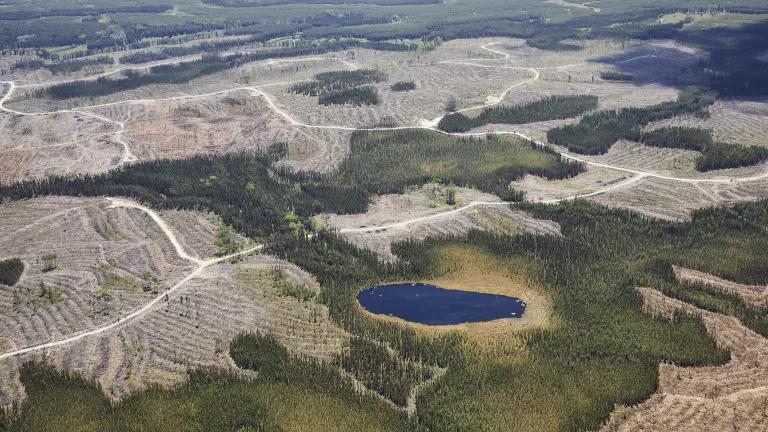IPCC to World: Protect More Nature to Maintain Life on Earth
This call to action is the closest thing we have to an endorsement from the global scientific community to protect and restore at least 30 percent of the world’s natural areas by 2030.

A rainbow arcs over the Selawik River in Alaska's Selawik National Wildlife Refuge
Steve Hillebrand/USFWS
The Intergovernmental Panel on Climate Change (IPCC) report, Climate Change 2022: Impacts, Adaptation, and Vulnerability, has a finding that is both sobering and incredibly timely for world leaders to consider as they approach negotiating a new global agenda for nature conservation in the midst of the climate crisis: It is urgent that we protect more land, inland water, and ocean areas to save species, ecosystems, and help secure nature’s contributions to people. This call to action is the closest thing we have to an endorsement from the global scientific community to protect and restore at least 30% of the world’s natural areas by 2030 (“30x30”).
And leaders can lock in that target this year when they adopt a new conservation framework via the Convention on Biological Diversity. Loosely, the Convention on Biological Diversity (CBD) is the nature conservation equivalent to the UN Framework Convention on Climate Change (UNFCCC). Just as the UNFCCC has adopted agreements such as the Paris agreement to combat the climate crisis, CBD has adopted targets and goals for nature conservation. It will do so again this year in Kunming, China, setting a conservation agenda for the rest of the decade called the post-2020 Global Biodiversity Framework. That conservation agenda will include a specific goal for protecting land, inland waters, and ocean areas, and they should follow the advice of the IPCC report to adopt a 30x30 target to help secure the healthy foundations of human society, like clean air, clean water, food security, flood control, and disease regulation.
We Must Protect and Restore at Least 30% of the World’s Natural Areas
The IPCC report finds that protecting and restoring areas is a key climate adaptation measure. Specifically, it states:
Protecting and restoring natural environments, such as forests and wetlands can reduce the risks climate change poses to people, as well as supporting biodiversity, storing carbon and providing many other benefits for human health and wellbeing. Climate change is bringing an increasing number of threats to people, including flooding, droughts, wildfire, heat waves and rising sea levels. These threats can however be reduced or aggravated, depending on how land, sea and freshwater are managed or protected. (IPCC WG2 AR6 FAQ2.5).
Protecting more natural areas will help build climate resilience and contribute to climate change mitigation. On the former point, the report finds “[t]here is also increasing evidence…that the loss and degradation of natural and semi-natural habitats exacerbates the impacts of climate change and climatic extreme events on biodiversity and ecosystem services.” (IPCC WG2 AR6 2.6.7). And on the mitigation side, “[l]arge scale protection and restoration of ecosystems can also make a significant contribution to climate change mitigation. Globally, there is a 38% overlap between areas of high carbon storage and high intact biodiversity…but only 12% of that is protected.” (IPCC WG2 AR6 2.6.7).
Answering the question of how much land, inland water, and ocean areas we should conserve, the IPCC report specifically identifies the need to protect at least 30%, finding that “30% or even 50% of land and sea needs to be protected or restored to confer adequate protection for species and ecosystem services.” (IPCC WG2 AR6 2.6.7).
Protecting and restoring more natural areas is a critical strategy for addressing the climate and nature crises. Protected areas are key for building climate resilience, they give species and ecosystems the literal space to adapt to climate change, and they contribute to climate mitigation. Protecting more areas is also critical for addressing the nature crisis, as land conversions are the number one reason species and nature’s contributions to people are in decline. As such, the CBD Parties must commit to protect at least 30% of land, inland water, and ocean areas as part of the post-2020 Global Biodiversity Framework.
We Must Protect More Natural Areas by 2030
The year 2030 is a critical target date for planetary health. The CBD Parties are orienting their targets and goals around 2030 and the IPCC report is clear that we must make changes now to protect biodiversity and habitat from climate threats. As the IPCC report notes, “The cumulative scientific evidence is unequivocal: Climate change is a threat to human well-being and planetary health. Any further delay in concerted anticipatory global action on adaptation and mitigation will miss a brief and rapidly closing window of opportunity to secure a livable and sustainable future for all.” (IPCC WG2 AR6 SPM.D.5.3). We simply can’t wait beyond the end of this decade to protect nature—to protect ourselves.
As the climate crisis continues and people are already suffering from climate change, we harm ourselves if we delay protecting more of nature.
Protection and restoration of natural and semi-natural ecosystems are key adaptation measures in light of clear evidence that damage and degradation of ecosystems exacerbates the impacts of climate change on biodiversity and people. Ecosystem services that are at threat from a combination of climate change and other anthropogenic pressures include climate change mitigation, flood risk management, food provisioning and water supply. (IPCC WG2 AR6 2-6).
Thus, we must start protecting and restoring vast swaths of the planet and we must do so now: “Climate change places additional stress on ecosystem integrity and functioning, adding urgency for taking action.” (IPCC WG2 AR6 2-8).
The overarching message from the IPCC is clear: Protecting and restoring at least 30% of land, inland water, and ocean areas by 2030 is critical for climate mitigation, adaptation, and resiliency and must be achieved without delay.
Achieving anything less than 30x30 will dismiss a wealth of scientific evidence demonstrating what’s needed to pass on any semblance of the world we know to future generations. 30x30 is a necessary and critical response to the climate crisis and the nature crisis.




